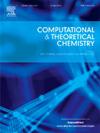基于锡的双金属体系催化甲烷解离活性的理论研究
IF 3
3区 化学
Q3 CHEMISTRY, PHYSICAL
引用次数: 0
摘要
本文提出了一种全面的密度泛函理论(DFT)研究锡(Sn)基双金属表面对甲烷解离的催化性能。本研究系统评价了催化活性过渡金属(Ni, Cu, Co, Fe)和贵金属(Au, Pt, Ag)在Sn表面的加入对CH4中C-H键断裂活化能的影响。电荷重分布分析表明,带正电的锡原子与带负电的掺杂金属之间的相互作用稳定了反应中间体,降低了活化能垒。在所研究的10种合金中,Sn-Co、Sn-Cu和Sn-Fe表现出最低的激活垒(约1.6 eV),表明它们具有很高的工业甲烷热解潜力。此外,研究还表明,对于基于Ni和Fe的双金属体系,掺杂金属浓度的增加会导致活化能的进一步降低。这些结果确定了锡基双金属催化剂是高效和可持续甲烷转化的有希望的候选者,有助于推动绿色制氢技术的发展。本文章由计算机程序翻译,如有差异,请以英文原文为准。

Theoretical investigation of catalytic activity of bimetallic systems based on tin for methane dissociation
This work presents a comprehensive density functional theory (DFT) investigation of the catalytic performance of tin (Sn)-based bimetallic surfaces for methane dissociation. The study systematically evaluates the effect of incorporation of catalytically active transition (Ni, Cu, Co, Fe) and noble (Au, Pt, Ag) metals into Sn surfaces on the activation energy for C–H bond breaking in CH. Charge redistribution analysis reveals that the interaction between positively charged Sn atoms and negatively charged dopant metals stabilizes reaction intermediates and reduces the activation energy barriers. Among the ten studied alloys, Sn–Co, Sn–Cu, and Sn–Fe exhibit the lowest activation barriers (about 1.6 eV), suggesting their high potential for industrial methane pyrolysis. Moreover, it is demonstrated that for bimetallic systems based on Ni and Fe increase of the dopant metal concentration leads to further reduction of the activation energy. These results identify Sn-based bimetallic catalysts as promising candidates for efficient and sustainable methane conversion, contributing to the advancement of green hydrogen production technologies.
求助全文
通过发布文献求助,成功后即可免费获取论文全文。
去求助
来源期刊

Computational and Theoretical Chemistry
CHEMISTRY, PHYSICAL-
CiteScore
4.20
自引率
10.70%
发文量
331
审稿时长
31 days
期刊介绍:
Computational and Theoretical Chemistry publishes high quality, original reports of significance in computational and theoretical chemistry including those that deal with problems of structure, properties, energetics, weak interactions, reaction mechanisms, catalysis, and reaction rates involving atoms, molecules, clusters, surfaces, and bulk matter.
 求助内容:
求助内容: 应助结果提醒方式:
应助结果提醒方式:


